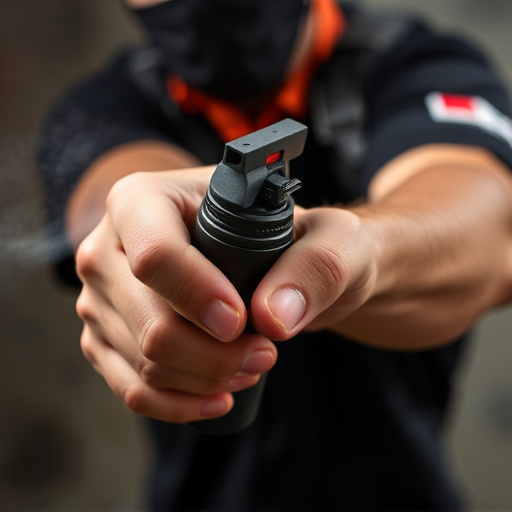Police-grade inflammatory pepper spray requires specific storage conditions, with optimal temperatures ranging from 15°C to 25°C (59°F to 77°F) or 50°F to 75°F (10°C to 24°C) for maximum potency and extended shelf life. Extreme heat or cold, as well as moisture, can degrade its effectiveness. Storing pepper spray in cool, dry areas away from direct sunlight, with temperature between 50°F to 70°F (10°C to 21°C), ensures readiness for emergency situations. Safety measures include secure storage, good ventilation, and eye/skin protection. Compliance with global guidelines and legal frameworks is crucial for responsible use.
“Discover the powerful compound behind police-grade inflammatory pepper spray, a tool used worldwide for crowd control. This comprehensive guide explores its composition, shedding light on active ingredients and their unique interactions. We delve into factors influencing effectiveness, emphasizing temperature’s role—especially the optimal best storage temperature for pepper spray—to ensure maximum potency.
Beyond composition, we address common misconceptions, safety precautions, and regulatory aspects, offering insights into the legal implications of this controversial yet essential tool.”
- Understanding Police-Grade Pepper Spray Composition
- Factors Affecting Pepper Spray Efficacy
- Ideal Storage Conditions for Optimal Performance
- Common Misconceptions and Safety Precautions
- Regulatory Considerations and Legal Implications
Understanding Police-Grade Pepper Spray Composition
Police-grade inflammatory pepper spray is designed to temporarily disable and control individuals, relying on a potent blend of capsaicin and other chemical agents. The composition varies among manufacturers, but key components often include capsaicin (the active ingredient found in chili peppers), piperine, and various additives for stability and effectiveness. Understanding the precise formulation is crucial as it dictates usage instructions, safety measures, and, notably, optimal storage conditions.
The best storage temperature for pepper spray is typically between 15°C to 25°C (59°F to 77°F). Extreme temperatures can compromise the integrity of the spray, reducing its potency and shortening its shelf life. Storing pepper spray in a cool, dry place away from direct sunlight ensures optimal performance when needed, making knowledge of the best storage temperature for pepper spray an essential consideration for law enforcement agencies and individuals alike.
Factors Affecting Pepper Spray Efficacy
The effectiveness of pepper spray is influenced by several factors, including environmental conditions and proper storage practices. One critical variable is the best storage temperature for pepper spray. Extreme temperatures can degrade the active ingredients in pepper spray, reducing its potency and shelf life. The ideal storage temperature range for most pepper sprays is between 50°F to 75°F (10°C to 24°C). Storing pepper spray outside this range can lead to faster spoilage and loss of effectiveness.
Additionally, proper storage involves keeping the containers sealed and out of direct sunlight. Exposure to light, moisture, and oxygen accelerates the degradation process. It’s also crucial to avoid freezing temperatures, as this can cause the chemical compounds to become less potent or even solidify, rendering the spray unusable. Maintaining optimal storage conditions ensures that pepper spray remains potent and ready for use when needed, maximizing its effectiveness during emergency situations.
Ideal Storage Conditions for Optimal Performance
To ensure optimal performance and longevity of your pepper spray compound, it’s crucial to maintain specific storage conditions. The best storage temperature for pepper spray ranges between 50°F and 70°F (10°C to 21°C). Exposing the spray to extreme heat or cold can degrade its effectiveness and alter its chemical composition.
Additionally, a dry environment is ideal, with humidity levels ideally below 60%. Moisture can cause the spray’s potency to diminish over time. Storing pepper spray in a cool, dry place, such as an indoor cabinet or locker, will help preserve its potency and ensure it remains ready for use when needed.
Common Misconceptions and Safety Precautions
Many people hold misconceptions about pepper spray, especially regarding its storage and handling. One common misunderstanding is that pepper spray can be stored in extreme temperatures without any adverse effects. However, this is not true; like most chemical compounds, the best storage temperature for pepper spray is between 50°F to 70°F (10°C to 21°C). Exposing it to excessive heat or cold can compromise its effectiveness and even cause damage to the container.
Safety precautions are paramount when dealing with pepper spray. Always store it in a secure, locked location, out of reach of children and unauthorized individuals. Ensure that the area is well-ventilated to prevent any potential buildup of noxious gases. Moreover, avoid direct contact with eyes, skin, or clothing; if exposure occurs, immediately flush with water for at least 15 minutes and seek medical attention if irritation persists.
Regulatory Considerations and Legal Implications
In the context of police-grade inflammatory pepper spray, regulatory considerations and legal implications play a critical role in ensuring both public safety and responsible use. Authorities worldwide mandate specific guidelines for the composition, handling, and storage of such agents to mitigate risks and maintain order. One key aspect is the best storage temperature for pepper spray, which must be carefully managed to preserve its potency and effectiveness. Exposing these compounds to extreme temperatures can alter their chemical structure, potentially reducing their impact as a control measure.
Legal frameworks also dictate how law enforcement agencies can employ pepper spray, emphasizing proportionality and necessity. Regulations often require officers to receive specialized training in the use of such agents, including when and how to deploy them without causing excessive harm. Balancing public order maintenance with individual rights protection is a delicate task, necessitating strict adherence to regulations and continuous evaluation of the latest scientific data regarding pepper spray compounds, including their storage requirements.
Police-grade pepper spray is a potent tool, but understanding its composition, efficacy, and proper storage is key to ensuring its effectiveness. By knowing the factors that influence its performance and the ideal best storage temperature for pepper spray, users can maximize its potential while adhering to safety precautions and regulatory considerations. This knowledge empowers individuals and law enforcement alike to make informed decisions regarding the use and handling of this powerful compound.
